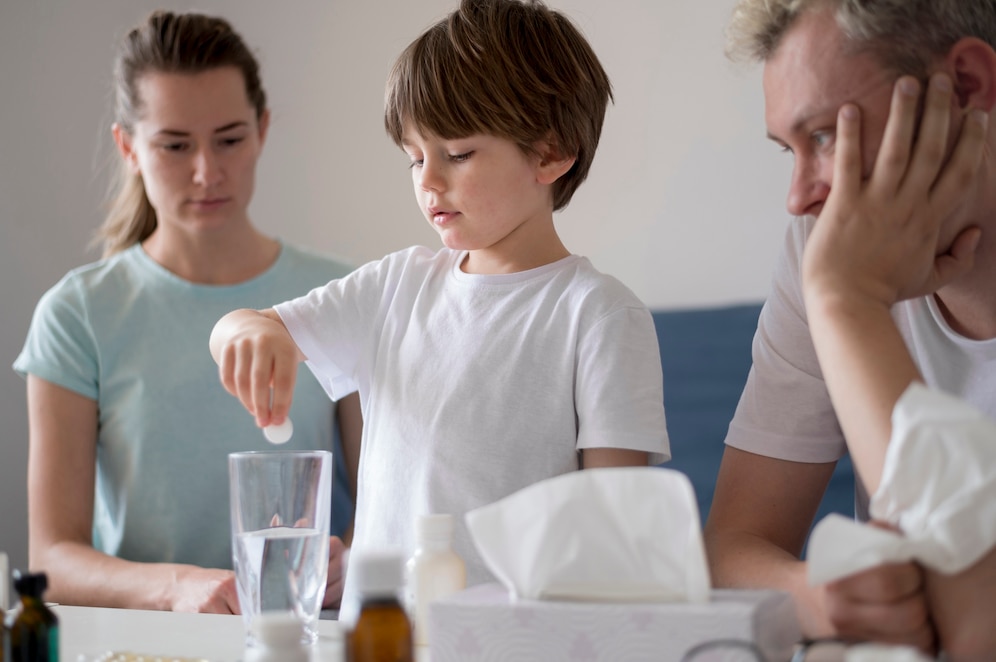Last updated on April 23rd, 2025 at 05:59 pm
How to Manage a Child Suffering from Fifth Disease?
A sore throat, runny nose, and low-grade fever are frequently the first symptoms of the fifth sickness. Following these symptoms, a facial rash may turn red and spread to the arms, legs, and trunk. The disease is known as slapped cheek disease because the rash is typically most noticeable on the slapped cheeks.
Normally, the fifth disease rash only lasts for two weeks. Occasionally, the rash may appear and disappear for several weeks. Fifth disease is often not critical, although those with compromised immune systems, such as young children and pregnant women, may experience more severe symptoms.
Defining the fifth disease
Erythema infectiosum, often known as the fifth sickness, is a common and typically contagious condition in kids. Because it ranks fifth in a chronological list of pediatric slapped cheek rash disorders, it is the fifth disease (the other four being measles, rubella, chicken pox, and roseola).
An infection brings it on with human parvovirus B19. Most kids are exposed to parvovirus B19 and develop antibodies to it.
Both kids and adults can contract the fifth illness, but kids between the ages of five and fifteen are more likely to get infected. Adults who work with children (such as teachers and childcare professionals) and who have never had the fifth illness infection are also more likely to get affected.
Fifth disease symptoms
The symptoms of the fifth illness are similar to those of other respiratory viruses: fever, sore throat, upset stomach, achy joints, and headaches. Unless your child is in pain, there is no need for treatment. You can search for generic medicines containing acetaminophen or ibuprofen to reduce fever and pain. There is no way to distinguish the fifth disease from any other virus.
Causes of Fifth disease
Human parvovirus B19, a virus that only affects humans, is the cause of the fifth disease. It spreads from person to person in the same manner as any viral cold. The infection is most frequently disseminated by sharing drinking or eating utensils or breathing in virus particles from the atmosphere after an infected person has coughed or sneezed.
Additionally, it can be transferred through blood transfusions and from an infected pregnant mother to her unborn child. The fifth disease rash stages are numerous.
Many children contract the illness during school or daycare outbreaks, and about half of them who live with someone with the fifth sickness do as well.
Incubation and contagion period i fifth disease
The virus typically takes four to fourteen days to incubate, but sometimes, it can take up to twenty days as well. Children and adults carrying the infection are contagious up to seven days before and up until the onset of the recognizable rash. A kid is no longer contagious once such symptoms of rash start to show.
Therefore, children who have developed a rash due to the virus can go to daycare or school and not infect their classmates. If any child is diagnosed with the fifth disease in school, the school administration is responsible for informing parents of other children who may have interacted with an infected child.
Diagnosis of fifth disease
The fifth disease in adults frequently goes untreated. When symptoms manifest, a doctor can typically diagnose the condition based on the signs, particularly the recognizable rash. Slapped cheek in adults is rare.
Blood tests can be used to determine a pregnant woman’s immunity to the virus or to look for antibodies to confirm the diagnosis. The fifth disease in pregnancy can be a cause of worry.
Treatment and prevention of fifth disease in child
Similar to treating a chronic ailment, you would need medicines for fifth disease. When children and adults are otherwise healthy, the fifth disease is typically a harmless disease that fades away without medical attention. The fifth disease has no specific treatment.
Doctors typically prescribe over-the-counter drugs like acetaminophen or ibuprofen to address symptoms, including fever, discomfort, and headache. Never administer acetylsalicylic acid (ASA) to children who have a viral illness; doing so has been associated with the potentially fatal disorder Reye’s syndrome. Avoid exposure to intense heat or sunshine if you or your child gets a rash because doing so could make it worse or cause it to return.
If your child is suspected of suffering from the fifth disease, consider generic medicine that can help address illness’ symptoms while being equally effective. Only the initial stages of the virus make the fifth sickness infectious. The infection is no longer contagious after the rash starts.
A vaccine cannot prevent the fifth disease. However, maintaining excellent hygiene, which includes thorough hand washing, can help stop the infection from spreading.
Conclusion
The fifth disease, parvovirus B19, is a viral infection that primarily affects children. Although the ailment is typically not serious, If you or your child has a fifth illness, it’s crucial to keep an eye out for any potential long-term repercussions and seek medical help if they manifest further.
What next?
Visit the Medkart store to avail medicines for the fifth disease. Our pharmacists will recommend you generic substitutes for prescribed medicines across our 107+ stores in India. Alternatively, you can visit our site medkart.in, download the Medkart android app or Medkart iOS app, and order from your mobile phone.
